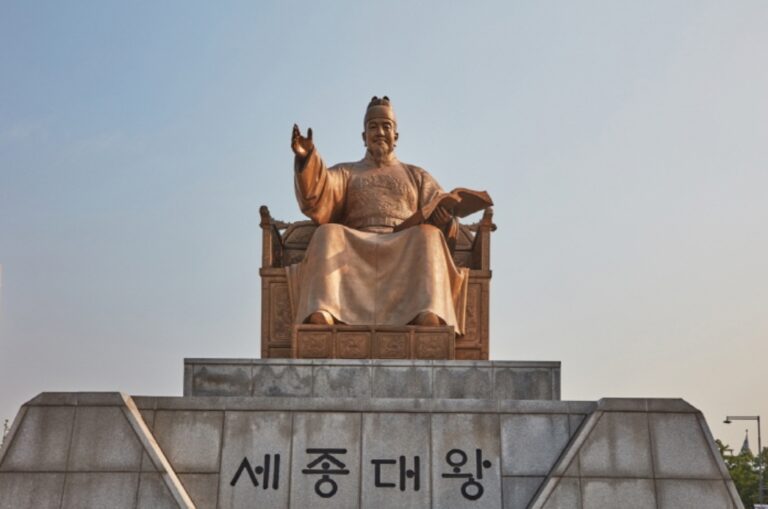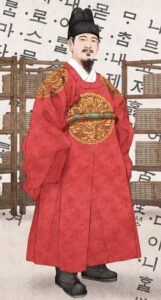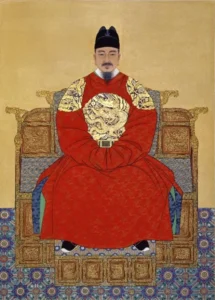King Sejong the Great (1397–1450) is one of Korea’s most revered monarchs, celebrated for his visionary leadership during the Joseon Dynasty. His reign marked a golden era in Korean history, characterized by significant advancements in science, technology, literature, and governance. Among his most notable achievements is the creation of Hangul, the Korean alphabet, which revolutionized literacy and education in Korea.

Early Life and Ascension to the Throne
Born as Yi Do in 1397, King Sejong was the third son of King Taejong. Despite not being the eldest, his intelligence and dedication to learning distinguished him from his siblings. In 1418, King Taejong abdicated the throne in favor of Sejong, recognizing his son’s capabilities and vision for the nation.

Early Life and Ascension to the Throne
Born as Yi Do in 1397, King Sejong was the third son of King Taejong. Despite not being the eldest, his intelligence and dedication to learning distinguished him from his siblings. In 1418, King Taejong abdicated the throne in favor of Sejong, recognizing his son’s capabilities and vision for the nation.
Hangeul’s design was scientifically innovative, with letters systematically representing phonetic sounds. This allowed for easier learning and broader literacy among the Korean populace, breaking the monopoly of the elite on written communication.
Advancements in Science and Technology
King Sejong’s reign was marked by significant scientific and technological progress. He established the Hall of Worthies (Jiphyeonjeon), an academic research institute that brought together scholars to advance knowledge in various fields.
Under his patronage, notable inventions and developments included:
- Water clocks and sundials: Improved timekeeping devices for agricultural and governmental use.
- Rain gauges: For measuring precipitation, aiding in agricultural planning.
- Advancements in printing: Development of metal movable type printing, enhancing the dissemination of literature and knowledge.
These innovations not only improved daily life but also strengthened the administrative efficiency of the Joseon Dynasty.
Military Reforms and Territorial Expansion
King Sejong implemented military reforms to protect and expand Joseon’s borders. In 1419, he launched the Gihae Eastern Expedition against Japanese pirates on Tsushima Island, curbing their raids and securing maritime safety. Additionally, he expanded the northern frontiers by establishing the Four Commanderies and Six Posts, fortifying the borders against Jurchen invasions

Cultural and Legal Contributions
King Sejong’s commitment to cultural enrichment and legal reform was evident throughout his reign. He promoted Confucian ideals, leading to the compilation of significant texts such as:
- “Yongbieocheonga”: A collection of poems praising the founding of the Joseon Dynasty.
- “Seokbo Sangjeol”: A biography of the Buddha, reflecting the king’s interest in Buddhism.
In the legal realm, he revised the penal code to ensure more humane treatment of criminals and implemented fairer tax systems, reflecting his dedication to justice and the welfare of his subjects.
Legacy and Commemoration
King Sejong’s legacy endures in modern Korea. He is honored with numerous memorials, including the King Sejong Statue in Seoul’s Gwanghwamun Plaza. His image graces the 10,000 won banknote, symbolizing his lasting impact on Korean society.
The annual Hangul Day, celebrated on October 9th, commemorates the creation of the Korean alphabet and underscores King Sejong’s contributions to Korean identity and culture.
King Sejong the Great’s reign was a transformative period in Korean history. His visionary leadership fostered advancements that not only elevated the Joseon Dynasty but also laid the foundation for Korea’s cultural and intellectual heritage. His commitment to education, innovation, and the well-being of his people cements his status as one of Korea’s most esteemed monarchs.
Other Relevant Readings
- King Sejong
- Joseon
- Jiphyeonjeon
- Hunminjeongeum
- Seonbi, Scholars of Joseon
- Yangban
Introduction & Hangeul >>
King Sejong the Great, Hangul creation, Joseon Dynasty innovations, Korean history, Korean alphabet, Sejong achievements, Korean cultural heritage, Hangul Day, King Sejong statue, Korean monarchs
